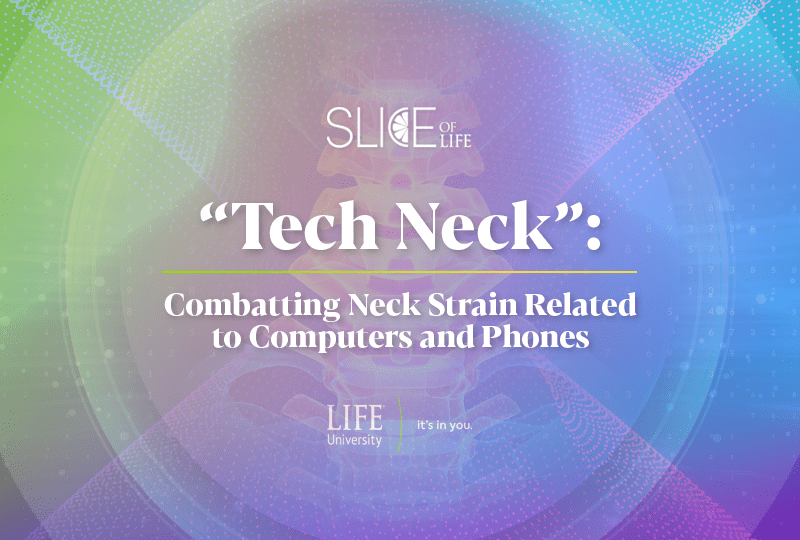As I write this, I myself am twisting and turning, sitting up straighter to alleviate my own potential “Tech Neck”. What is Tech Neck exactly? And more importantly, how can you avoid or alleviate this rather annoying and potentially damaging pain?
According to an article by the Foundation for Chiropractic Progress (F4CP) titled “How to Triumph over Tech Neck”, Tech Neck is the shortened form of a relatively recently observed phenomenon dubbed “Tech Neck Syndrome”. Don’t let the cute name fool you, because neck strain is a serious matter that should be addressed sooner rather than later.
Any formal diagnoses or suspected health issues of any kind must of course be discussed and verified by your chiropractor and/or other primary care professionals. With that in mind, let’s look at what Tech Neck is and how to improve posture to prevent or ease neck strain.
“The clinical condition refers to the onset of cervical spinal pain that is a result from the repeated stress of frequent forward head flexion while we look down at mobile devices or glide our heads forward with bad posture working at a computer screen. It can result in pain, headaches, muscle spasm, a change in the natural curve of the spine, and ultimately a premature degeneration of the spinal joints and deformity,” stated the article by F4CP.
In layman’s terms, the more time you spend with your head hunched over a computer or a phone screen, the more likely that poor posture will result in pain, breathing changes, balance issues and in severe cases deformities over time.
So, what can we do to fight back and give our necks a rest? One major staple of chiropractic education that chiropractors regularly instill in their patients is the importance of proper posture and proper positioning in a standard workstation to allow for better alignment. Ergonomics of the office or homework station play a major role in that, as employees and students often spend hours at a time, day in and day out in these positions. Best practices related to effective body positioning with computer ergonomics can help to maintain a comfortable working posture where all joints of the body are aligned.
So, let’s see what F4CP and OSHA suggest to perfect our postures at the computer:
- Keep a level head, literally. You should keep your head position in line with your torso and your spinal column.
- Try to keep your shoulders relaxed, hanging normally and not stiffly,
- Tuck in those elbows close to the body, bent between 90-120 degrees.
- Make sure you back is fully supported with appropriate lumbar support
- Keep your feet flat on the floor or on a footrest.
- Your knees should be at a 90-degree angle to the floor, with thighs and hips parallel to the floor.
Even with the world’s best posture, movement is key. Staying in one position for too long isn’t healthy. Make sure to stand up periodically, stretch and walk around. As for phone usage, cutting back on screentime helps but when you need to use your phone, don’t let your neck lean forward. Consider using a prop for the phone and using voice or other features that might reduce the need to look down at the phone.
Here are some great exercises from F4CP you can try to help you become a posture pro!
Finding Position: This exercise is about as simple as it gets. Simply stand with your back against a wall, shoulders touching the wall, neck straight with the back of the head touching the wall, heels of your feet touching the wall, feet shoulder width apart. Step away from the wall and maintain that position.
Chin Tuck: Glide the chin backward until the head is over the spine. Do not tilt your head back, as this is a gliding motion. Two fingers over the chin is helpful to guide the motion. Hold the position for 10 seconds and repeat. Variations of this can be performed against a wall, on the floor or seated. Glide the head back and then actively push against resistance and hold for 10 seconds. You will feel the muscles at the lower part of your skull contract.
Chest Stretch/Shoulder Roll: When the head hangs forward typically the chest is more contracted and the back muscles between the shoulders are stretched. This exercise does the opposite of that. Roll your shoulders and hold positions that stretch the chest muscles. Think of it as trying to touch your shoulder blades together.
Additional references for more information (from original F4CP article):
- https://www.bankmycell.com/blog/how-many-phones-are-in-the-world
- https://www.census.gov/content/dam/Census/library/publications/2021/acs/acs-49.pdf
- Int J Environ Res Public Health. 2021 Feb; 18(4): 1565. Published online 2021 Feb 7. doi: 10.3390/ijerph18041565 PMCID: PMC7914771 Text Neck Syndrome in Children and Adolescents Daniela David, Cosimo Giannini, Francesco Chiarelli, and Angelika Mohn* https://www.ncbi.nlm.nih.gov/pmc/articles/PMC7914771/
- https://www.osha.gov/etools/computer-workstations/positions


Social Media